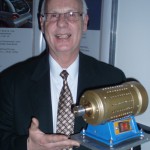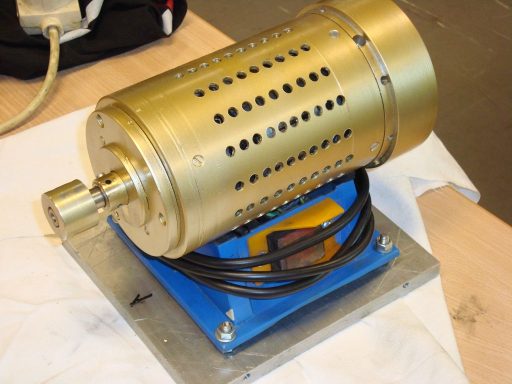
Bert Harju with the Harju motor, Finalist in Environmental Innovation 2009
Quick information about the invention
Some important
connections for Electric generator/Electric motor technology.
The synchronous speed consists of: The number of poles and the input frequency 50 Hz
this gives the speed. This means that this rule governs the manufacturing process for
standard types.
Series for the idle speed of today's asynchronous motors at
different speeds/min: 3000, 1500, 750, 375, 187.5. The number of poles: 2, 4, 6, 8, 10
The increase of a pair of poles means that: the size, the weight, the
manufacturing price becomes in parity with the number of poles.
This is
particularly noticeable in larger products where size and weight are of great
importance the total function of a plant.
In today's standard products is the
stator fixedly mounted in the outer casing which means that the rotor is the part that
rotates as well transmits the electrical pulses emitted from the stator during
operation.
What occurs during the operating ratio with load on the output
shaft, will be that the rotor speed will vary which means that the magnetic
transmission between stator/rotor will also vary, this means that the magnetic energy
produced from the stator does not fully come to be transferred due to the speed
variations during the work phase, this in turn gives rise for heat generation in the
stator/rotor. Which in turn reduces the output power. Corresponding functions also
include the electric generator technology in the standard version.
New important connections regarding the Harju Electric Generator/Electric Motor
technologies.
The innovation briefly meant the following: Through
a mechanical converter of the rotation regarding both the stator/rotor functions with
the same standard components, the rotation speed/2 is obtained, which means:
Applicable Electricity Generator: at 50% of the speed, the same
output power is obtained as the standard has at its synchronous speed, (the
synchronous speed has decreased by 50%), At the same speed as by default, the
output power is doubled. This is made possible by the converter doing the same
work as a pole pair in the generator.
The current electric motor is
obtained in the same way 50% of the synchronous speed, which means the following:
Electric motors synchronous speeds occur in the same way which gives an extra pole
pair function, which lowers the speed by 50%. but at the same time the torque
increases by twice as much standard in the same size. Because it input the 50Hz
frequency to the stator for one revolution in the standard version, this means that
the rotor receives double the frequency/revolution which explains the power increase
from the electric motor.
The magnetic pulses produced by the innovation's
rotary transducers come from the stator to the rotor always output synchronously to
each other this 2 times/revolution, which means that the previous variations depending
on load as well as network variations completely absent, heat decreases, energy
transfer increases.
The input the electrical energy of the electric
motor increases only by about 3% for this work effort, this depends of the energy
conversion being performed between the stator/rotor inside the motor by the same
supplied energy. Adjusting the rotor in the working position of the stator, we carry
out the assembly, there measurement takes place of the output power.
Overall, the same output power is obtained from the electric motor corresponding to
twice the physical size as standard.
This means lower cost, smaller
size/weight. External control of the speed is not required.
The
innovation also enables both the electricity generator and the electric motor to speed
is steplessly controlled, from 0 to the synchronous speed, this with minimal losses,
as the rotating energy is transferred between the stator respectively, rotor depending
on whether it is generator or electric motor function that applies.
The
regulation thus takes place internally between the stator/rotor functions.
Henceforth, the new technology will be called: H-electric generator respective
H-electric motor. (H stands for Harju technology)
Information
about Harju Electric motor technology
Formula for calculating the speed of
an electric motor; n=2x50x60/2 = 3,000 rpm.
In the case of HIGHER frequencies
60 Hz. n=2x60x60/2 = 3,600 rpm. (+ 20%) + forces 20%. Each increase in speed by 10Hz
increases motor power by 20% according to the formula.
The stator winding is
wound on an H-electric motor as standard for the same speed as today's electric motors
2800 rpm.
The innovation means that the stator and rotor rotate towards through
a transfer device each other absolutely synchronously. In this way, the double
peripheral speed is obtained as well double the number of electrical
pulses/revolution, thus 50% of the rotational revolution 1400 rpm is obtained because
double magnetic pulses are obtained below the rotation.
Today's electric motor
technology with solid states provide an uncontrolled transmission of the magnetic
pulses between stator rotors depending on whether the transmission takes place with
varying load and variations of the supply current from the mains during operation.
This in turn means that generated magnetic energy from the stator does not completely
transfer to the rotor, which in turn provides increased heat development in the
stator's iron package.
Innovation enables higher energy transferred between
stator and rotor, minor heat losses as well, this transfer of the magnetic force
occurs with maximum power, depending on the adjustment of the transmission is
performed by setting the gears for the best position during assembly, which occurs
2 times/rotation speed for all poles, this adjustment is not changed during continued
operation of the electric motor.
The energy gain obtained corresponds to the
energy that the transmitter requires for its work.
The innovation means that
double energy is extracted at 1400 rpm. this WITHOUT the supplied supply energy
increasing significantly by (2-3%).
The basis for the new technology is
that the added 50Hz the frequency of the stator, through against the rotation gives
the rotor 2x50Hz rotational speed which thus quite naturally the engine's torque
increases by about 100% at 1400 rpm.
Thus the result is:
A.
Increased torque on motor shaft.
B. Halved speed.
C.
Possibility to halve the physical size without to reduce motor power, thus weight and
manufacturing costs can also be reduced which has a certain interest in the market.
D. An additional advantage will be when the motor shall be used with a lower
speed than the synchronous speed 1400 rpm and a controller is switched on so that
adjustment can be performed, this means that motor power decreases by about 15%/100
rpm reduction through losses due to that the motor decreases power by decreasing the
speed against the synchronous speed that the motor is designed for. This is a common
major problem that has not been resolved today.
E. Because the
H-electric motor has a higher power at its synchronous speed (1400 Rpm) and thus can
allow the load to occur at a lower speed WITHOUT the same losses being obtained, our
motor will solve most of today's similar load situations in a more efficient way for
the user.
F. The innovation means that the H-electric motor produces
double electric pulses between the stator/rotor WITHOUT the number of poles increasing
physically in number by 100%, which gives weight, price, easier manufacturing etc. as
a result.
G. The innovation means that the H-motor synchronous speeds
lie at 1500 rpm current, 50 Hz connection. About higher speeds If desired, a gear unit
is fitted to the electric motor as before. However, it is more common to lower speeds
than today's synchronous speeds 3000 Hz are usually relevant. It should be noted that
regardless of the speed at which the H-electric motor operates, the dual torque is
obtained at standard motors, furthermore the maximum magnetic power transmission
between stator/rotor is always obtained, regardless of whether the motor is loaded or
the incoming drive current varies, this depends on the transfer between stator/rotor
always takes place synchronously, can not be changed during operation.
H. Additional benefits are obtained by the pivot mass under the engine rotation
is increased by about 3 times towards today's electric motor, which means that the
torque is maintained better, with smoother running than is the case with day
technology.
The new electric motor can be manufactured in the same
sizes/designs as today's electric motors varying brands today market in their markets,
manufactured/assembled in similar factories like today, etc. The H-electric motor is a
good replacement for power and space prioritized for good functioning.
Information about the Harju Generator
Today's Elgenerator technology
works with a fixed stator and free rotating rotor, which means that the electricity
generating pulses from the stator do not have a maximum transmission of these
electrical pulses. In addition, electricity generation will vary the speed is
continuous.
The innovation means that the stator and rotor rotate towards
exposed to each other from the outer casing, this makes it possible to precisely
control the transmission of magnetic force between the rotor and the stator.
This is done by a transmission gear converts the rotation to exactly opposite rotation
between them as in addition, is adjustable, to measure it during the final assembly of
the generator most efficient position between rotor/stator which increases the power
and not least they decrease transmission losses that occur when the poles during the
standard function work with stationary stator and rotor rotating at high speed past
each other.
As is well known, the resistance of the electric winding increases
when it is heated, which in turn decreases machine output. The possible load that the
gear unit makes up is effectively replaced with the benefits of adjusting the magnetic
transmission between the poles.
The innovation can be compared to mounting
double the number of poles on the same unit, which means that the generator reduces
the speed by 50% and increases the input power by about 100%. In addition in addition,
the diameter increases significantly and the weight and cost increase.
The
innovation means that the diameter increases by about 30 mm, and the weight by 0.5 kg
corresponding size. The input power increases in the same way by 100% at 50% of the
speed for the same output power.
The benefit of the innovation is that the
speed will be lower as well the adaptation to the driving unit, means that the gearbox
gear ratio can be reduced by 50% which results in weight and cost reduction.
About the driving unit operated at the same speed as standard, the output power
increases by 100% from the generator.
An additional advantage is that
electricity generation starts much earlier at rotation which results in more generated
current pulses/unit of time which means improved profits even in lower winds regarding
wind power. The generator can be built in different sizes and adapted for their tasks.
- Bert Harju
The improved inventions of Bert Harju

Electric motor
This new electric motor and its
companion the electric generator has double the output thanks to counter rotating
stators and rotors in the same size as an ordinary electric motor or electric
generator. Or the same output in half of the size of as an ordinary electric motor
or electric generator.
At
Chalmers, Göteborg.
A test to compare the drive energy for the new electrical generator versus a standard
generator was made. The test showed that the new electrical generator used only 1643.5
Watts input energy compared with the standard generator that used 2629.6 Watts input
energy for the same output. It means that with a standard electrical motor. The new
electrical generator used 986 Watts less input energy than compared with a
standard electrical generator for the same output.
Bert Ivan Harju - Motor-or a Generator-Related Arrangement US 7,786,634
back to linkpage
suggestion
read and sign my guestbook


